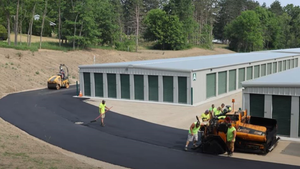Metal-Roof Coatings
July 1, 2003

A high-quality roof-coating system includes a biodegradable cleaner to prepare the surface metal, industrial grade caulk for repairs at seams and protrusions, and an elastomeric coating made from 100 percent acrylic resins. The added benefit of an acrylic roof coating is it will remain permanently flexible, allowing the metal to expand and contract with fluctuations in temperature. White or light-colored coatings also reflect UV heat from the sun from the building surface, significantly reducing interior temperatures.
The following is an overview for the proper application of a liquid-applied, acrylic roof coating over metal roofing. The use of this type of acrylic coating system is tax deductible as a maintenance expense and, with proper maintenance and occasional recoating, it will last for the life of the building.
The Surface Inspection
Roof surfaces should be clean, dry, structurally sound, stable and well-secured.
The roof surface should be free of excessive ponding water. Roof surfaces that pond water 48 hours after a rain are considered unacceptable. All water shall be allowed positive drainage from the roof.
Inspect the condition of flashing details adjacent to protrusions, penetrations, roof-mounted equipment, curbs, walls, parapets, drains and the roof edge to ensure they are acceptable and will maintain a weather-tight installation after being properly reinforced and coated.
Surface Preparation
Metal surfaces to be coated should be clean, dry, sound, and free of dirt, grease, oil and any other contaminants that might interfere with the adhesion of the elastomeric acrylic coating.
All mechanical fasteners should be checked for integrity. Retighten or replace them as necessary. "Stripped out" fasteners should be replaced using a fastener with a larger diameter.
Unsound rust should be wire-brushed, sandblasted or mechanically abraded. Metal panels deteriorated to the point that their structural integrity is compromised should be replaced.
Remove excessive amounts of asphaltic-based or other deteriorated patching/flashing materials, if present.
Check all seams to ensure they are tight and flush. Excessive gaps or deflection between panels should be eliminated by installing additional screws or rivets as necessary to restrict deflection to 1/4-inch or less.
All metal surfaces, new or existing, should be cleaned using a biodegradable cleaning product as specified by the coating manufacturer.
All existing sound but rusted areas should be primed with the appropriate metal primer as recommended by the coating manufacturer.
Fill gaps between 1/4-inch and 1/2-inch at panel seams, joints and protrusions with the recommended caulk. Fill gaps larger than 1/2-inch, such as at the ridge cap, roof edge and/or interface of dissimilar materials, using polyethylene backer rod or spray-applied polyurethane foam.
Reinforce all horizontal (end-lap) and vertical (side-lap) seams that have not been factory crimped or presealed; roof terminations and flashings around drains, scuppers and skylights; the base of all vents, conduits, HVAC equipment and other protrusions; and the interface of any metal with a dissimilar material using one or more of the following methods:

2. Cut a length of butyl-backed, woven reinforcing tape to the desired length. Peel off the release backing, center the strip over the detail area and press it firmly into place, removing all wrinkles and bubbles. A wallpaper-seam roller is helpful in securing the tape to the metal deck.
3. Apply a butter-grade sealant, using a brush, roller or airless spray, to a thickness of 60 to 80 dry mils over the detail area. Extend the sealant a minimum of 1 inch on either side of seams, joints and interfaces.
All mechanical fastener heads should be treated using one of the following methods:
1. Apply a butter-grade sealant to completely encapsulate the screw head, and seal the base of the fastener to the metal deck.
2. Apply a butyl-backed, foil-faced reinforcing patch by centering the cap over the fastener head and pressing it firmly in place to seal the cap flush around the base.
Elastomeric Coating Application

1. Apply the basecoat at a minimum rate of 1 gallon per 100 square feet.
2. After allowing the basecoat to dry, apply the topcoat at a minimum rate of 1 gallon per 100 square feet. Apply the elastomeric coating by airless spray, using a multipass spray technique to ensure even coating application to all sides of the metal-panel corrugation. Make a conscious effort to apply coating into crimped or presealed vertical (side-lap) seams that have not been detailed.
3. The total basecoat/topcoat minimum dry-film thickness required at any location is 15 mils. This is generally considered the minimum coating thickness for a five-year product warranty. For extended coverage periods, additional coats and heavier film builds will be required.
Cleanup
Maintain work and work areas in a clean, safe condition at all times during coating installation. Remove excess materials, trash and debris from the job site daily. At the completion of the project, clean the area of any spills and containers, and clean up all roofing debris, leaving the job site in a clean, orderly condition.
Clint Whitsett works for United Coatings, a Greenacres, Wash.-based manufacturer of Roof Mate, a water-based, 100 percent acrylic elastomer designed to extend the life of existing roofs by forming a permanently flexible, reflective membrane. For more information, call 509.926.7143 or visit www.unitedcoatings.com.
You May Also Like





